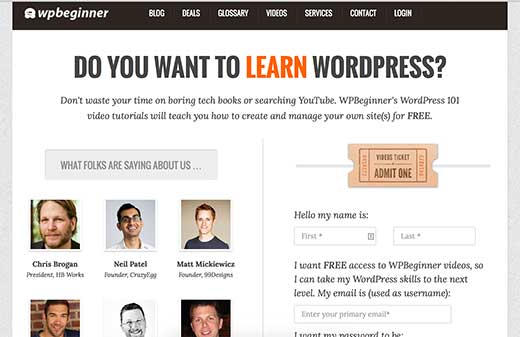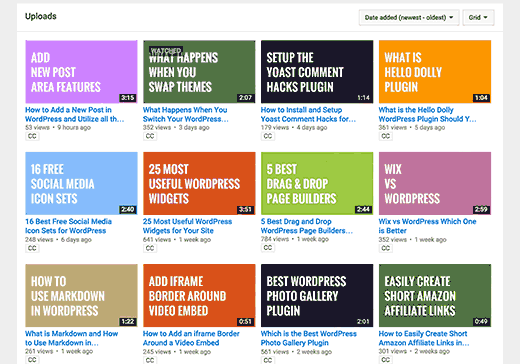Friday, July 31, 2015
Bing Tests Emoji Keyboard
Which is the Best WordPress Slider? Performance + Quality Compared
Are you looking to add a slider in your WordPress site? Tired of going through hundreds of WordPress slider plugins to see which one is the best? Well you’re in the right place. In this article, we will compare 5 of the top WordPress slider plugins based on their speed, ease of use, and overall features. The goal is to find which is the best WordPress slider plugin.
Many WPBeginner readers, quickly graduate the beginner level and step into theme customization. One of the most often asked questions by our readers is what is the best WordPress slider plugin? In this article, we will try to answer that question by comparing some of the best WordPress sliders for performance and quality.
The Problem With WordPress Sliders
Most WordPress sliders are slow. If it is not properly coded, a slider can significantly increase your page load time. If you do not have a good WordPress hosting service, your server may respond even slower than normal.
The other problem with WordPress slider plugins is ease of use. Most of them are bloated and come with a learning curve for beginners.
Last but not least, you want to make sure that your WordPress slider is responsive. A lot of them are not.
So how do you go through hundreds of sliders plugin and check for all of this? Well you don’t have to. We did the research for you and below are our results for the best WordPress slider.
The Contenders for Best WordPress Slider Plugin
For the sake of this article, we chose 5 of the top and highly recommended WordPress slider plugins. While doing our research, we noticed that these slider plugins were among the most used and recommended. We decided to run some simple tests and see how each one of them performs. The criteria we are looking for is speed, ease-of-use, features, and compatibility.
Speed
Page load time and speed are an important factor to consider when adding a slider to your WordPress site. As mentioned earlier, not only a slow site affects user experience, but it also hurts your search engine rankings. This is why slider speed is our #1 priority during this test.
| Slider Plugin | Page Load time | Requests | Page size |
|---|---|---|---|
| Soliloquy | 1.34 secs | 26 | 945 KB |
| Nivo Slider | 2.12 secs | 29 | 1 MB |
| Meteor | 2.32 secs | 27 | 1.2 MB |
| Revolution Slider | 2.25 secs | 29 | 1 MB |
| LayerSlider | 2.12 secs | 30 | 975 KB |
As you can see in the above scores, Soliloquy was the fastest loading WordPress slider in our tests. The reason why it is the fastest loading slider is that the code is optimized for speed.
The plugin also uses a neat little trick. It loads your cover slide and then rest of the slides are loaded asynchronously. It is not just fast on tests, it feels fast to your visitors too.
If you want a high performance fast WordPress site, then Soliloquy is the best WordPress slider for you.
Ease of Use
Creating sliders is not as simple as we would like it to be. The goal here is to find a plugin that even beginner level users can use to create sliders both quickly and easily.
Soliloquy
We have worked on and tested many WordPress slider plugins, but so far we have found none as easy to use as Soliloquy. Installing it and creating a slider in it is extremely simple (see our guide on how to easily create a responsive WordPress slider with Soliloquy).
The reason why it’s easy to use is because it uses the WordPress coding guidelines and blends in with your native WordPress admin interface. Soliloquy has a simple but intuitive user interface to create slides using the default WordPress media uploader.
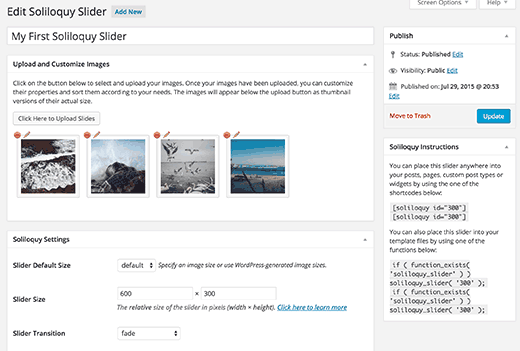
There are shortcodes, template tags, a button on post editor, and widget to add your slides to different sections of your website.
Nivo Slider
Creating a slider with Nivo Slider was easy and quite straight forward. You can choose the images from the media uploader, and upload multiple new images at once. You can also drag and rearrange slide order. Using the same media uploader interface, you can add captions, link, and alternate text to your slide images. It comes with shortcodes and template tags so you can add a slider to your posts, pages, and template files.
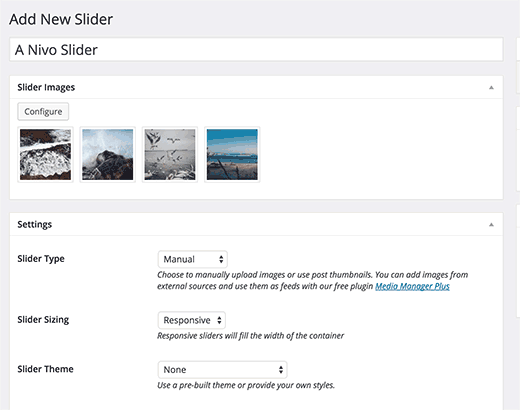
Nivo Slider does not support video and other multimedia type. Meaning this is limited to only image slideshows. It comes with a nice bundle of themes that you can use and lots of transition effects to choose from. Plugin settings, creating slideshows, and adding slides to posts/pages is all very straight forward and smooth. However, if you are counting on features and options, then Nivo falls behind Soliloquy.
Meteor Slides
When creating a slideshow with Meteor Slides you need to upload or select each slide individually. This is time consuming and many new users would probably find it confusing. After installing the plugin, go to Slides » Add New. Give this particular slide a title, and then click on set featured image to upload your slide.
If you want your slide to link to a page, then you can enter a URL. Lastly, you need to choose a Slideshow from Slideshows meta box.
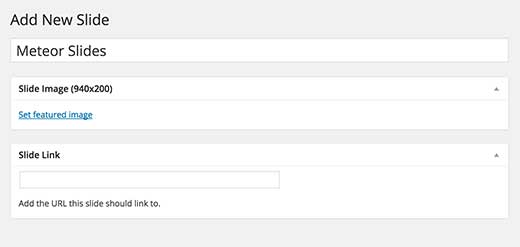
You can not arrange the slide order in a slideshow. You can not add a video slide, or add text over your slide. This makes Meteor Slide very limited in functionality. However, it is useful if all you want to do is add a simple slideshow.
Revolution Slider
Creating a slider with Revolution Slider is not as straight forward because it separates the slider and slides creation process. When create a slider, you will see all the customization options such as resizing, thumbnails, animations, etc, but you will not see the ability to add slides which is confusing.
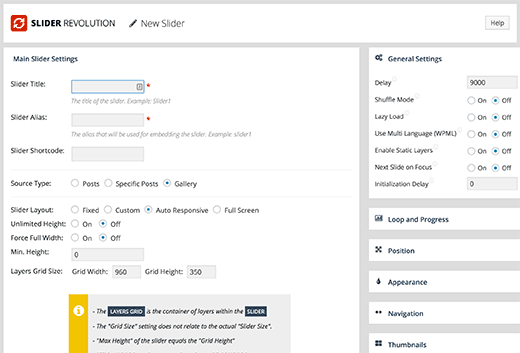
After creating your slider, you have to come back to the slider list in order to find a button to add your slides.
The user interface looks and feels different than rest of the WordPress UI. There are way too many options and the user interface does not help you easily locate the ones you need.
LayerSlider
LayerSlider is similar to the Revolution Slider because it has it’s own user interface which does not match rest of the WordPress UI. There are far too many customization options which can be good for some, but may complicate the creation process for beginners.

Creating your first slider with LayerSlider is not intuitive however there are helpful links to documentation that can help you get started.
Features
If all you want to do is create simple image slide shows, then Nivo Slider and Meteor Slides are both good enough to work with.
Soliloquy, Revolution Slider, and LayerSlider come with a lot more features. They are fully responsive and look equally beautiful on all devices and screen sizes. All three of them support video slides, HTML 5 videos, featured content slides, themes, animations and transitions.
Revolution Slider and Layer Slider both have their own user interface that may feel complicated to new users specially since these plugins bundle all the features in one.
On the other hand, Soliloquy offers a much easier and friendlier user interface to take advantage of all the features. Instead of packing everything in one plugin, Soliloquy uses addons for advanced features which allows you to install only what you need and keep your site bloat free.
Pricing
Another decisive factor that might help users choose a slider plugin for their site is pricing. Here is the price for a single site license of these plugins. Meteor Slider is a free plugin so it is not listed here:
| Slider Plugin | Single Site License |
|---|---|
| Soliloquy | $19 |
| Nivo Slider | $29 |
| Revolution Slider | $18 |
| LayerSlider | $17 |
After comparing these plugins we feel that the best WordPress slider plugin award goes to:
Soliloquy is by far the fastest WordPress slider plugin in the market. It follows all of the coding best practices, it is very well documented, it is easy to extend for developers and even easier to use for users, and last but not least it is also the cheapest.
Use our Soliloquy Coupon to get an extra 25% off.
We hope this article answers the questions regarding the best WordPress slider plugin in terms of performance and quality. Which is your favorite WordPress slider plugin? Let us know by sending a tweet to @wpbeginner on Twitter.
To leave a comment please visit Which is the Best WordPress Slider? Performance + Quality Compared on WPBeginner.
The Ultimate List of Product Hunt Collections for Marketers
Say you want to get started on a new marketing strategy—collecting customer research, or creating cool images, or measuring ROI.
Where do you go first to find the tools that’ll make your job as smooth as can be?
I often turn to listicles and roundups that bundle together a big handful of helpful tools. And this is maybe why I love Product Hunt’s collections so much. Their collections are user-generated tools lists that are easy to browse and simple to find just the tools that I need.
I’m happy to share with you some of my favorite collections, and I went ahead and turned many of the most popular Buffer tools posts into collections also. Hopefully for any social media marketing strategy you’re keen to try next, there’ll be some useful ideas here in these collections!
What is Product Hunt?
Product Hunt is a website where new digital products and tools are discovered and upvoted by a community of folks like me and you.
What is a Product Hunt collection?
A Product Hunt collection is a bundle of tools that have been mentioned on Product Hunt, bundled by a common theme.
12 Helpful Buffer Tools Collections
1. Create Beautiful Images for Social Media (collection)
Visuals have been a key part to our marketing strategy both on the Buffer blog and on social media. We’ve seen great engagement with our image tweets and updates, and we’re grateful for some really cool tools that make image creation easy and seamless. Our favorites are included here in this collection.
Tools featured here:
- Coolors
- Pablo
- Infogram
- The Pattern Library
- The Noun Project
- Placeit
- UnSplash
- Icon Finder
- Aviary
- Canva
- Subtle Patterns
- Over
- CloudApp
- Recite
- Skitch
For even more image creation tools, see our original post on the Buffer blog: 23 Tools and Resources to Create Images for Social Media
2. The $0 marketing stack (collection)
Free marketing tools get me quite excited. I love the chance to explore and experiment with a free tool to see how it can help me save time or supercharge my marketing efforts. The list of tools in this collection all represent free alternatives to popular paid tools.
Tools featured here:
- Charlie
- Hotjar
- Medium
- Google Analytics
- Buffer
- Sidekick
- Peek
- Segment
- SumoMe
- Canva
- Wistia
- Simply Measured
For even more Twitter tools, see the original post on the Buffer blog: The $0 Marketing Stack: Free Options to Popular Paid Services and Tools
3. Where to Find Great Content to Share (collection)
Finding great content can be key to a social media strategy if you’re into sharing articles and videos relevant to your brand. We’ve found a few great ways to discover these shareable bits of content, many of which we’ve listed here in this collection.
Tools featured here:
- Panda
- Medium
- Sidebar
- Growth Hackers
- Daily
- NYT Now
- Inbound.org
- Nuzzel
- MediaREDEF
- BuzzSumo
- Quibb
- Prismatic
- Contently
- The Latest
- NextDraft
- LinkedIn Pulse
- News.me
For even more Twitter tools, see the original post on the Buffer blog: Always Have an Amazing Link to Share: 25 Newsletters and Tools to Discover Shareable Content and 17 Unique Places to Find Great Content to Share
4. Twitter tools (collection)
We recently refreshed the Twitter tools post on the Buffer blog to include the new tools that have come up since we first published, nearly two years ago. The article mentions 90 tools now (90!), and I’ve added many of the top ones to the Product Hunt collection here.
Tools featured here:
- Pablo
- Spruce
- Twindr
- Stats for Twitter
- Buffer
- SocialRank
- Mention
- TUNS
- Daily 140
- Rite Tag
- Hash
- Riffle
- Share as Image
- Nuzzel
- SocialCount
- TweetDeck
- BuzzSumo
- Twitshot
- Filta
- Twitteriffic
- Followerwonk
- Beatstrap
- The Latest
- SumAll
- Klout
- Keyhole
- Twilert
- Tagboard
- Seen
- SocialBro
- Tweriod
- Twurly
- Warble
For even more Twitter tools, see the original post on the Buffer blog: The Big List of Twitter Tools: 91 Free Twitter Tools and Apps to Fit Any Need
5. Facebook tools (collection)
We’ve enjoyed coming across useful Facebook tools here and there—tools that show you benchmark stats for your page, tools that reveal info into your follower demographics, and more. It seems that Twitter tools are a bit more ubiquitous than Facebook, yet there’re still a number of great ones here that can help boost your Facebook marketing.
Tools featured here:
- ShortStack
- AdRoll
- Agora Pulse
- Facebook Page Barometer
- EdgeRank Checker
Tools featured here:
For even more Twitter tools, see the original post on the Buffer blog: How to Run a Facebook Contest, Analyze Your Page, and More: 11 Ideal Facebook Tools for Marketers
6. Social media analytics tools (collection)
Measuring the performance of your social media posts is a strategy that can look any number of different ways. Whether strictly ROI focused or more loosely into engagement and sentiment, you can find a tool to track just about any analytics taste. Here are a few that we’ve found to be quite useful.
Tools featured here:
- Riffle
- Google Analytics
- Iconosquare
- Followerwonk
- Cyfe
- SumAll
- Klout
- Keyhole
For even more Twitter tools, see the original post on the Buffer blog: Know What’s Working on Social Media: 19 Free Social Media Analytics Tools
7. Customer research tools (collection)
This collection of tools is one near and dear to my heart, as I really enjoy the chance to reach out directly to your audience and get their feedback. The tools mentioned here include survey tools, heat maps, user testing, and more.
Tools featured here:
- Typeform
- Heat-Map
- Survmetrics
- SurveyPal
- User Testing
- Click Insights
- Qualaroo
- Survata
- Usability Tools
- Temper
For even more Twitter tools, see the original post on the Buffer blog: Get to Know Your Audience: 18 Incredibly Useful Market Research Tools
8. Best Free Tools for Small Businesses (collection)
What makes for a small business tools? It’s likely that a lot of the small business tools mentioned here are also used by big businesses as well. What makes these particular useful for the small biz is that these tools are free and easy-to-use. You can get up and running with these tools in little time and for little money.
Tools featured here:
- Buffer
- SocialRank
- Mention
- Flare
- Twtrland
- IFTTT
- Nutshell
- Rapportive
- Canva
- Tweetdeck
- BuzzSumo
- Followerwonk
- Shared Count
- Keyhole
- News.me
- Rival IQ
- Tweet4me
- Social Bro
- Tweriod
For even more Twitter tools, see the original post on the Buffer blog: The Big List of The 61 Best Social Media Tools for Small Business
9. Browser extensions (collection)
Saving time online is a key focus for us here on the Buffer marketing team. And one way we go about doing that is with some high-powered browser extensions. These are a few that we find particularly useful.
Tools featured here:
- Giphy
- Rite Tag
- Riffle
- Social Analytics
- Feedly Mini
- Bit.ly
- Evernote Web Clipper
- Instagram for Chrome
For even more Twitter tools, see the original post on the Buffer blog: The 15 Best Browser Extensions to Improve Your Social Media Marketing
10. Mobile apps and tools (collection)
It’s amazing the work you can get done from your phone. This collection of mobile apps offers a little bit of everything for the on-the-go digital marketer.
Tools featured here:
- Trello
- Overcast
- Buffer for iOS and Android
- Evernote
- MailChimp Snap
- Mention
- Asana
- IFTTT
- Daily
- Aviary
- Facebook Paper
- Hipchat
- Over
- Nimble
- Prismatic
- Flow
For even more Twitter tools, see the original post on the Buffer blog: 45 Best Mobile Apps and Tools for Marketers: How to Manage Social Media From Anywhere
11. Blogging tools (collection)
We’re grateful for the chance to experiment with a lot of different types of tools here on the Buffer blog. Several tools are included in our daily workflows of brainstorming, researching, note-taking, writing, editing, publishing, and sharing. Here’s a collection of our favorites.
Tools featured here:
- Trello
- Hemingway
- Wunderlist
- Evernote
- KeywordTool.io
- Quora
- Todoist
- Grammarly
- Canva
- Share As Image
- Death to the Stock Photo
- Blog Topic Generator
- Desk App
- BuzzSumo
- Toggl
- Digg Digg
- Filament
- Egg Timer
- Meme Generator
For even more Twitter tools, see the original post on the Buffer blog: 39 Blogging Tools to Help You Work Faster, Write Better, and Land More Readers
12. SEO tools (collection)
How much time do you spend on SEO for your website or blog? We spend a few minutes per blog post, and this time is well spent thanks to the SEO tools on hand. This collection mentions some real time savers, and they can be used whether you’re an SEO expert or not.
Tools featured here:
- Nibbler
- Keywordtool.io
- SimilarWeb
- MozBar
- Google Trends Visualizer
- ahrefs
- Check My Links
For even more Twitter tools, see the original post on the Buffer blog: 21 Simple and Free SEO Tools to Instantly Improve Your Marketing
10 Useful Product Hunt Collections for Marketers
1. Free stuff for startups (collection)
A fun collection by Hiten Shah that covers 55+ free tools. It’s an incredibly exhaustive list, full of some of our favorite tools that we use every day here at Buffer, too.
2. 20 great podcasts for entrepreneurs (collection)
Not only a great list of podcasts for founders, but also a really useful list for anyone into learning about growing a business.
3. Personal assistant apps (collection)
Looking to offload some of your to-do list? These tools can help with a huge variety of items like research, scheduling, errands, and more.
4. Startup tool kit #4 (collection)
Each of Product Hunt’s Startup Tool Kit offerings has been really great (here’s a link to #1, #2, and #3), and for some reason #4 just really caught my eye. I’ve felt a yearning to try most every tool listed here, so maybe it’s a tug of wanderlust. You’ll note that these tool kits originally were intended as discounts or giveaways, and that some of the savings may have since expired.
5. Tools for marketers and growth hackers (collection)
This list of 34 tools covers a great range of marketing tasks, things like image creation, email newsletters, Twitter content, and more.
6. The 1,000 upvote club (collection)
Looking for the most popular Product Hunt products? They’re on this list, which collects only those products with 1,000 votes or more. Startup Stash holds the top spot with 3,000+ votes.
7. Newsletters you’ll love (collection)
Featuring 25 popular newsletters in the business and marketing scene, this collection makes it easy to find and discover a favorite new newsletter (or two).
8. To-do apps (collection)
For those looking to stay organized and on top of things, this collection has 27 ideas for new tools to try.
9. Tools for writers (collection)
This list of tools covers some really useful products that help with the writing process: word processors, ebook creators, dictionaries, and more.
10. Slack tools (collection)
If you use Slack to communicate with your team at work, there are some really neat integrations that can tie into your Slack rooms—things like brand monitoring, scheduling, live chat, and even Product Hunt notifications.
Bonus: Just for fun
Things for your desk (collection)
I don’t own anything from this list, but I’d love to! There’s stuff here like whiteboard laptop covers, mod notebooks, standing desks, and busy indicator lights.
Become a GIF master (collection)
Talk about an irresistible headline! I’d love to become a GIF master! There’re some really cool tools here like the Giphy Chrome extension and YouTube GIF Creator.
Over to you: What are your favorite products?
I’d be so excited to hear which products you most enjoy.
Which ones save you time?
Which ones do you use every day?
Feel free to leave any thoughts or tips here in the comments, and I’ll get right back to you!
Image sources: Pablo, Unsplash, IconFinder
The post The Ultimate List of Product Hunt Collections for Marketers appeared first on Social.
How to Choose a Perfect Color Scheme for Your WordPress Site
Are you having a hard time deciding on your website’s color scheme? Choosing the right color combination not only increases your site’s visual appeal, but it can also generate favorable response from your visitors in terms of sales and conversions. In this article, we will show you how to choose a perfect color scheme for your WordPress site by understanding the psychology of colors and using one of 4 amazing resources.

Psychology of Colors
It is a well researched theory that colors can affect human responses. Colors have an emotional pull on our decisions and choices we make in our everyday life.
Large corporations spend millions of dollars building a well crafted brand image and identity for their products. They hire experts to pick just the perfect combination of colors for their brands and products.
The colors you use on your site are part of your brand image. You need to choose colors that generate a favorable emotional response for your brand and products.
So how do you figure out which colors and what kind of response you are looking for?
Lucky for you, marketers and psychologists have done plenty of research already. Take a look at this infographic:

- Red: is the color of youth and joy. It reflects boldness and confidence.
- Green: Creates a soothing calming effect, it evokes a peaceful, progressive, and calm emotional response.
- Blue: It reflects trust, strength, reliability.
- Black: Black generates a sophisticated, solid, secure emotional response.
- White: Clarity and simplicity are the two major effects of White.
- Yellow: Yellow is the color of optimism, warmth, friendliness.
- Orange: Orange creates a fun, friendly, confidence, and cheerful effect.
- Pink: Sensuality,femininity, romance, and love are the emotions associated with Pink.
Other Things to Consider
This goes without saying that colors need context to work the way you want them to work. Your brand or product may already have certain associations that may or may not work with the colors you are choosing.
Here are a few things you should consider before picking up a color scheme for your site:
First, you need to consider the existing brand image. If you already have a logo and other marketing materials, then you may want to use the existing colors.
You also need to consider which colors will look good on the web. Things that look great on print can look quite different on screen. Think about other media like sliders, videos, images, call to action buttons, etc that you will be adding to your site. Think about what colors you will be using the most.
Creating a Color Scheme
Hopefully, by now you have figured out the appropriate colors for your website with the psychology of colors in mind. We recommend you to choose at least two colors that articulately represent your brand, and the response you want to get from users.
Once you have those colors, there are several online tools that you can use to generate an unlimited number of color palettes.
1. Adobe Color CC

Formerly known as Kuler, Adobe Color CC is a great tool to generate color palettes. You can select color rules, and then spin the wheel. You can manually adjust each color in the palette and rest of the colors will be automatically adjusted to match the color rule. You can also generate color palettes by uploading photos.
2. Photocopa by COLORLovers

Colorlovers is one of the most popular destinations for color inspiration and ideas. They have some great tools to generate color schemes. One of them is PhotoCopa which allows you to generate a color scheme from photos. You can also use their basic tool which generates colors combinations by simply selecting a color.
3. Material Palette

Inspired by Google’s Material Design concept, Material Palette allows you to generate color schemes using the design rules. It is designed to inspire color schemes to be used in mobile apps but these color schemes can easily be used for websites as well.
4. Coolors.co

Coolors is a wonderful color scheme generator. Simply hit the space bar to generate color schemes. You can modify a color in the scheme manually and lock it down. You can also download color schemes to use in your projects later.
We hope this article helped you choose the perfect color scheme for your WordPress site. You may want to look at our article on how to easily customize WordPress with CSS Hero.
If you liked this article, then please subscribe to our YouTube Channel for WordPress video tutorials. You can also find us on Twitter and Facebook.
Infographic by The Logo Company
To leave a comment please visit How to Choose a Perfect Color Scheme for Your WordPress Site on WPBeginner.
Google Given Right to Appeal in Safari Cookies Case
Thursday, July 30, 2015
25 Actionable Social Media Strategies You Can Implement Today [Free Ebook!]
We’re incredibly grateful to have the chance to learn from others and experiment for ourselves with what works best on social media.
And we’re so very happy to share our best strategies with you!
To collect all these favorite tips in one place, we’ve compiled our top 25 social media strategies into a free ebook that you can download below. We’ve included strategies for Twitter, Facebook, Pinterest, and more—all of which you can implement today, in just a few minutes and just a few clicks.
Get your free copy of the Social Media Strategies ebook!
Read further for a full list of the strategies that are included as well as a sample page from the book.
25 Actionable Social Media Strategies You Can Implement Today
The full ebook includes 25 social media strategies that we’ve pulled from some of the most popular Buffer blog posts. Each of the 25 is something that we’ve personally tried or currently have on our to-do list. In every case, these are strategies that we greatly recommend trying. Here’s the full list:
- Share the same content multiple times
- Include an animated GIF in “thank you” tweets
- Add to your Buffer in bulk
- Move your social sharing buttons around (or get rid of ’em)
- Use current events to boost your Facebook post visibility
- Use BuzzSumo to see who’s sharing your content
- Use a dummy account to save a reservoir of validated tweets and updates
- Tweet to landing pages with specific asks
- Include an image in your tweets
- Ask questions
- Organize accounts into Twitter lists
- Enlist a group of supporters to engage with your content
- Find and engage with influencers in your area
- Get your team sharing with you and for you
- Reserve your name on all social media platforms
- Schedule routine drive-bys of your social media accounts
- Respond to everyone
- Go to your archives to share evergreen content.
- Choose 1 to 3 areas of expertise
- Use as many of these 7 Twitter bio tips as possible in your bio
- Test your posting frequency. Here’re some ideas.

- Create a 4:1 ratio of types of tweets/updates.
- Hide your vertical Pinterest images in your articles by changing their height & width.
- Sort your stats to find your best updates
- How to show your boss or client the value of social media
A sample chapter from the book
This is the first chapter from the book: Tip #1 – Share the same content multiple times.
Each strategy is short and to-the-point, with an explanation on how to get started and why we’ve found the strategy to work.
What to do with all these strategies
One thing we love to mention with recommendations like these is to treat them more as inspiration rather than prescription.
Use these strategies as the basis for your own experiments on social media rather than adopting them straight away as your new normal.
We’ve tried to keep this in mind as we test out new strategies here at Buffer, and it’s an area that I feel I can definitely keep improving. An example that comes to mind: We often hear that there are a few ideal times to publish social media updates during the day. And every time I hear these studies I seem to adjust my Buffer schedule straightaway. Turns out, few of these best times have ended up to be true for us. Our best times seem to be at non-peak hours or at different intervals of the day, given our international audience.
The takeaway: Test out these strategies for your social media plan, and continue on with the ones that work.
The strategies mentioned in this ebook are the ones that have worked for us—for whatever reason—and we think it’d be cool if they’d inspire you all to try new things or think outside the box.
And we’d love to hear back on how your experiments go!
Grab your free copy of the ebook. And send in your feedback!
Get your free copy of the Social Media Strategies ebook!
Ebooks are a new experiment for us also. We’d love to learn:
Is this type of content helpful for you?
Would you like us to do more?
I’d be so grateful to hear any thoughts or feedback here in the comments on whether you’d like us to continue to pursue more ebooks down the line. I know I’ve got lots of room to improve on the ebook front also, so any thoughts on your experience with this version would be so greatly appreciated!
The post 25 Actionable Social Media Strategies You Can Implement Today [Free Ebook!] appeared first on Social.
Wednesday, July 29, 2015
How to Make the Most Out of WPBeginner’s Free Resources
Often new WPBeginner readers ask us how they can get the maximum benefits from all the free resources available on our website. WPBeginner is one of the largest free WordPress resource sites on the planet. We have been publishing free WordPress guides, how to tutorials, and videos since 2009. In this article, we will show you how to make the most out of WPBeginner’s free resources.

1. Subscribe to WPBeginner Newsletter

Signing up for our newsletter is the best way to stay updated with WPBeginner’s new posts and resources. When we write a new article, it will land directly in your email inbox. You can select the email frequency such as WPB Daily or WPB Weekly.
You can also select the sections you want to subscribe to. We recommend you to check all the boxes to get the maximum benefit.
2. Signup for Our FREE Video Tutorials
If you are just starting out with WordPress, then our WordPress Beginners Videos should be your first destination. We hate to see many big companies selling such basic education for hundreds of dollars. This is why we decided to make it available for Free.
These HD quality videos are prepared by our experts and are built for beginner level users. Our 23-step easy to follow video tutorials cover from the basics to advance WordPress topics and will help you get started with WordPress in no time.
3. Join our YouTube Channel
With nearly 20,000 subscribers, WPBeginner’s YouTube channel is the best WordPress channel on YouTube.
We regularly upload new videos with useful how to articles aimed at beginner level users. These videos are short, sweet, and easy to follow. You will also get the video transcript, a text version of the tutorial, and you can even ask questions in the comments.
Joining our YouTube channel, will help you stay up to date, brush up your WordPress skills, and discover new tools and plugins for your website.
4. Follow us on Facebook and Twitter

You can also follow us on Twitter and Facebook. This way you can participate in our community discussions, see what new posts we have published, get in touch with us, and leave your comments and feedback.
We like to hear from our users. In fact, many of our post ideas come from user requests made on Twitter.
5. Got a WordPress Question? Here is How to Find The Answer
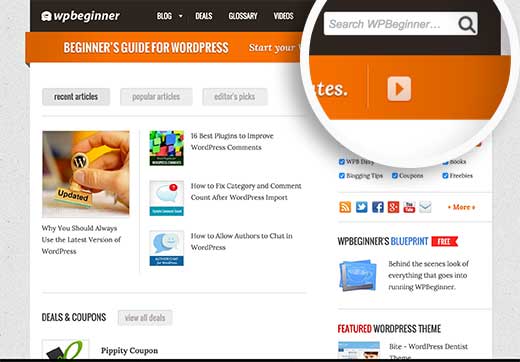
At the top right corner of every page on WPBeginner, there is a search box. This search box is powered by Google Custom Search. It is fast and highly accurate.
Simply type the question you wanted to ask us. There is a very good chance that we have already written about it.
6. Can’t Find an Answer? Drop us a Line or Tweet to us
If you have searched WPBeginner and didn’t find an answer to your question, then you can reach us using the contact form on our website.
You can also tweet to us @WPBeginner. We try our best to get back to you with an answer or point you in the right direction within 1 business day.
We love hearing from our users because that’s what keeps us motivated and inspired.
7. Need Plugin and Theme Recommendations?
Many beginners are concerned about which plugins they should use on their WordPress site or how to find the perfect theme. Visit WPBeginner’s Showcase section where we hand-pick the best WordPress plugins and themes. Here are some places to look at:
- 20 must have WordPress plugins for 2015 (Expert pick)
- 40 useful tools to manage and grow your WordPress blog
- 37 simple WordPress themes you should try
- 43 Beautiful free WordPress blog themes
Want to know which WordPress plugins and tools we use on WPBeginner? Check out WPBeginner’s Blueprint where you will find all the tools and plugins we use to run WPBeginner.
8. Hidden Gems

Over the years we have built quite a few awesome resources. The two that you should absolutely check out are our WordPress dictionary and WordPress deals.
WPBeginner glossary is the best place for beginners to start and familiarize themselves with the WordPress lingo. In other words, we help you translate the WordPress gibberish that you may come across.
WPBeginner Deals is the best place to find exclusive discounts on WordPress products and services. Because we have such an awesome community, a lot of WordPress businesses have decided to offer our users exclusive discounts.
So the next time you decide to buy a premium WordPress plugin, theme, or another service, then it’s probably best to search our deals area. You may save 10 – 60% off.
9. Want to Learn More About WPBeginner?

Are you curious about who runs WPBeginner? Why it’s free and how it works? Check out our about page. We started out as a small blog to help our clients learn how to use WordPress. Since then we have grown and become one of the most popular destinations on the web for WordPress related resources.
You may also want to check out the personal website of our founder and CEO, Syed Balkhi. You can find him on Twitter as well.
10. What Else We Do?
WPBeginner is a project of Awesome Motive Inc. Our parent company runs hugely popular websites like List25.
We also sell some of the most successful WordPress related products such as Soliloquy, Envira Gallery, and ThemeLab.
One of our premier products is OptinMonster, the best lead generation solution on the web.
We hope this article helped you learn how you can make the most out of WPBeginner’s free WordPress resources. You may also want to take a look at how to learn WordPress in a week or less.
If you liked this article, then please subscribe to our YouTube Channel for WordPress video tutorials. You can also find us on Twitter and Facebook.
To leave a comment please visit How to Make the Most Out of WPBeginner’s Free Resources on WPBeginner.
Yelp Earnings Report Shows Strength In Mobile Search
Search Ads to Target App Downloaders
Fixing Other People's 404s for Link Building
How to Add Email Subscriptions to Your WordPress Blog
Do you want to add email subscription to your WordPress blog? Recently, one of our users asked us what is the best way to subscribe by email option in WordPress? In this article, we will show you how to add email subscriptions to your WordPress blog and start building your email list.

Why You Should Add Subscribe via Email Option to Your Site?
While social media is a great way to interact with your readers, email is the most reliable and direct way of communication. By offering email subscription on your blog, you can build a steady stream of regular visitors for your site.
Email subscription also gives your users yet another way to consume your content as some folks may not be on social media. See our complete guide on why you should start building your email list right away.
Often beginners think that adding email subscription is some complicated process. That’s not true at all.
The WordPress RSS to email subscription setup is quite straight forward, and it will take you less than 30 minutes. Once you set it up, your readers will automatically get daily or weekly emails containing your new content.
Now since there are multiple services and plugins that allow you to setup email subscriptions in WordPress, we will only cover the top 3 email subscription plugins and services.
MailChimp RSS to Email
MailChimp is one of the most popular email marketing service providers. It is a paid service, but they do offer a free option for those with less than 2000 subscribers.
To quickly get started with MailChimp see our guide on using MailChimp and WordPress.
For the sake of this article, we are assuming that you have signed up for MailChimp and created your first email list. The next step is to setup an RSS to Email campaign.
Simply visit Campaigns » Create Campaign to create a new campaign.
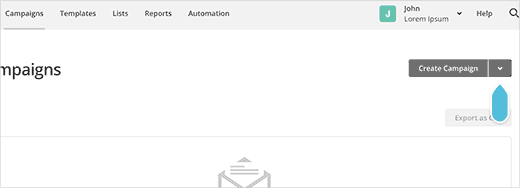
MailChimp will now show you different types of campaigns that you can create. You need to click on the RSS Driven Campaign option.
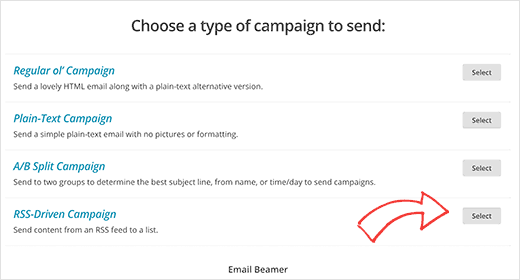
This will bring you to the campaign settings page where you need to provide your WordPress site’s RSS feed link. Your feed URL is yoursite.com/feed/
You will also need to choose the time and frequency of emails. You can choose to send daily, weekly, or monthly emails.
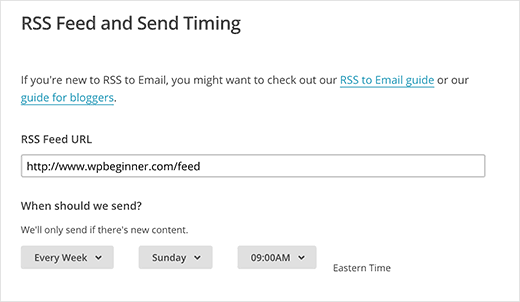
On the next page, you will have to provide campaign info. You will notice that MailChimp has already pre-filled most fields on the page. These settings should work for most blogs, but feel free to change them as needed.

Now you need to click on the next button to select a template for your emails. MailChimp allows you to customize the template by adding your own logo, by-line, and any other elements that you may want to add.

When you are finished customizing, click on the next button and then click on Save and Exit.
That’s all, you have successfully created your WordPress RSS to Email newsletter using MailChimp.
To add the email subscription form to your website, simply visit the Lists page on your MailChimp account and click on the downward arrow icon next to your email list. After that select signup forms from the menu.
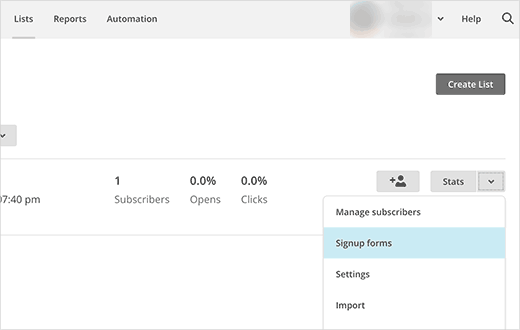
MailChimp will then ask you, what kind of signup form you want to create. Select Embedded Forms.
On the next screen, you can customize your email sign up form and generate the embed code. You can then copy and paste this code in a text widget on your WordPress website.
Alternatively, you can use OptinMonster a plugin created by the WPBeginner team that will make this process a lot easier and offer you pretty signup forms, floating bars, slide-ins, exit-intent popups, and more.
Aweber RSS to Email
Aweber is another popular email marketing service provider. It’s a paid service, but they offer a 30 day free trial. A lot of bloggers and internet marketers prefer to use AWeber.
If you are just joining Aweber, then you will be directed to create your first email list when you login for the first time.
Once you are logged into your Aweber dashboard, simply visit Messages » Blog Broadcasts.
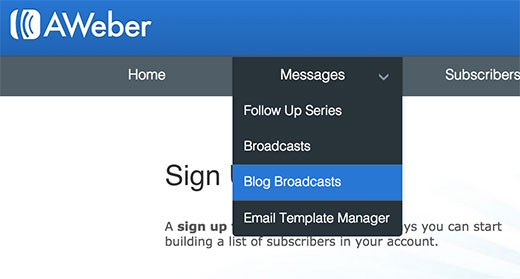
On the next screen, click on the green button labeled ‘Create a Blog Broadcast’.

This will bring you to the new page where you can setup your RSS to email campaign. First you need to enter the URL of your blog’s RSS feed. After that you need to provide a subject line for the emails.

Scroll down a little, and you can choose a template for your email. Select the one you like and then click on load template.

After choosing your template, scroll further down to configure time and frequency of emails. You can setup to send an email as soon as new item appears in your RSS feed. You can also send daily, weekly, or even monthly email digests.

Once you are done setting up these options, you need to click on Save Blog Broadcast button.
That’s all, you have successfully set up Aweber RSS to email subscription.
If you have not already added the email signup form to your WordPress site, then the next step is to add a signup form to your WordPress sidebar. Simply click on the ‘Signup Forms’ in the Aweber dashboard to design your email signup form.

Follow the on screen instructions and save your form. Finally you will reach the publish section. There you need to click on the ‘I will install my form’ button and copy the form embed code.
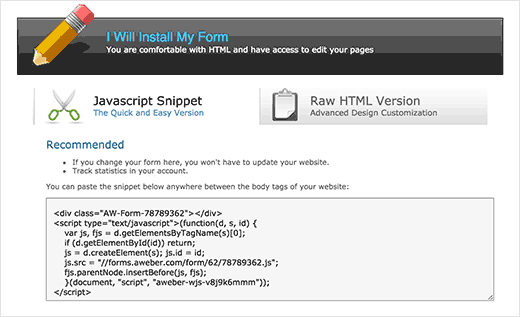
Now go to Appearance » Widgets on your WordPress site and paste this code in a text widget.
Alternatively, you can use OptinMonster a plugin created by the WPBeginner team that will make this process a lot easier and offer you pretty signup forms, floating bars, slide-ins, exit-intent popups, and more.
Using JetPack Subscriptions
JetPack is another option for users who want to add email subscriptions to their WordPress site. It is completely free, but the downside is that you don’t control your list.
JetPack Subscriptions is not a full newsletter. For example, if you wanted to send an email apart from your daily blog posts, then you will not be able to do that using JetPack Subscriptions. Also, if later you decide to move to a proper email marketing service which most bloggers do, then your users will have to opt-in to the email list again.
Having said that, here is how to add JetPack email subscriptions to your self hosted WordPress site. First thing you need to do is install and activate the JetPack plugin. Upon activation, the plugin will add a new menu item labeled JetPack to your WordPress admin bar. Clicking on it will take you to the plugin’s settings page.

JetPack plugin requires you to create a WordPress.com account and link your site with it (See our guide on the difference between WordPress.com and self-hosted WordPress.org sites). If you have a WordPress.com account, then you can use that or you can create a free account.
Once you have connected JetPack to WordPress.com, you need to visit Appearance » Widgets. Drag and drop Blog Subscriptions (JetPack) widget to a sidebar and then click on Save button store your widget settings.
You can also enable subscription option below your comment form. Visit Settings » Discussion page and scroll down to the JetPack subscription section. Check the box next to blog subspcription and comment subscription options. Click on the save changes button to store your settings.
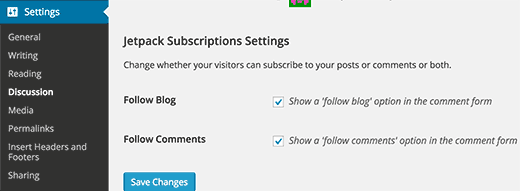
That’s all you have successfully set up JetPack email subscriptions on your WordPress site. If you ever want to move to another email service, here is how to switch from JetPack subscriptions to MailChimp, Aweber, etc.
We hope this article helped you add email subscription to your WordPress blog. You may also want to check out how we increased our email subscribers by 600% using OptinMonster.
While there are dozens of other plugins and services that allow you to setup email subscriptions for your WordPress blog, above are the ones that we recommend. For those who are wondering, we use MailChimp and OptinMonster to handle WPBeginner email subscriptions. Here’s a tutorial on how to create a daily and weekly email newsletter in WordPress similar to WPBeginner.
We hope this article helped you learn how to properly add email subscriptions to your WordPress blog. You may also want to check out our email marketing 101 guide to kickstart your email list.
If you liked this article, then please subscribe to our YouTube Channel for WordPress video tutorials. You can also find us on Twitter and Facebook.
To leave a comment please visit How to Add Email Subscriptions to Your WordPress Blog on WPBeginner.












